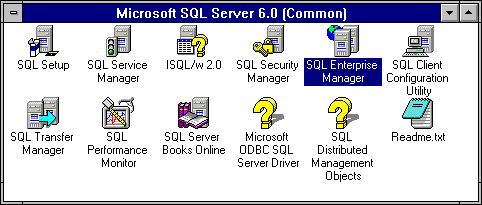
After the server is upgraded, you may need to perform several configuration tasks, such as setting server configuration parameters, setting security parameters, and registering the server and adding it to a server group. For some post-upgrade configuration tasks you use SQL Enterprise Manager; for other tasks, you use SQL Setup. These applications can be started from the Microsoft SQL Server 6.0 program group, shown here:

You can use SQL Enterprise Manager to configure many server options. For a newly installed server, you would typically use SQL Enterprise Manager to:
Of course, SQL Enterprise Manager has additional substantial capabilities. For information on using SQL Enterprise Manager, see the SQL Enterprise Manager online Help or the Microsoft SQL Server Administrator's Companion.
You can use SQL Setup not only to install new software and upgrade existing software, but also to configure the server after installation and install specific components. After a server is installed, you can use SQL Setup to:
Important SQL Setup updates the Windows NT Registry with all the information required to run SQL Server. If you need to update any of the information written to the Registry, reconfigure the installation options by running SQL Setup again or by running SQL Enterprise Manager, rather than using the Windows NT Registry editor (regedt32). Using SQL Enterprise Manager or SQL Setup protects you from inadvertently changing entries that should not be changed and ensures that the integrity of the Registry is maintained.
For more information on configuring a server after installation or upgrade, see the Microsoft SQL Server Administrator's Companion.